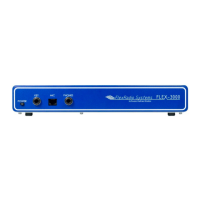
Do you have a question about the FlexRadio Systems Flex-3000 and is the answer not in the manual?
| Brand | FlexRadio Systems |
|---|---|
| Model | Flex-3000 |
| Category | Transceiver |
| Language | English |
Guide to choosing a place for the FLEX-3000, considering contents and placement.
Factors to consider when placing the FLEX-3000 in your shack for optimal integration.
Details on front and back panel connections for the FLEX-3000 transceiver.
Steps to install and configure the FireWire driver for computer connection.
Powering up the FLEX-3000 and installing detected new hardware components.
Setting up the FlexRadio driver via the Control Panel for optimal performance.
Adjusting sample rate and buffer size for optimal performance and latency.
Selecting the appropriate operation mode for system stability and performance.
Using the DPC latency checker to determine optimal system configuration.
Guidance on upgrading an existing PowerSDR installation to a new version.
Step-by-step instructions for installing the PowerSDR software on your computer.
Initial setup wizard for PowerSDR after installation, including radio model selection.
Configuring essential PowerSDR parameters before operation, including calibration.
Setting audio parameters like buffer size and sample rate in PowerSDR.
Adjusting display appearance and behavior for spectrum, waterfall, etc.
Digital Signal Processing settings for noise reduction, filters, and blankers.
Tailoring transmit signal characteristics with compression and filtering.
Power Amplifier settings, including gain adjustment per band.
Customizing the visual appearance of the PowerSDR front console elements.
Assigning keyboard shortcuts for PowerSDR functions for efficient operation.
Setting up Computer Aided Transceiver (CAT) control for third-party software.
Performing diagnostic tests on the FLEX-3000 and PowerSDR software.
Key to understanding basic controls in the PowerSDR front console window.
Managing tuning frequencies, VFO sync, lock, and data transfer.
Displaying and interpreting RX and TX signal parameters.
Selecting bands and using band stacking memories for frequency, mode, and filter.
Selecting the desired demodulation routine and mode-specific controls.
Adjusting filter bandwidths and parameters for different modes.
Controls specific to phone, CW, and digital modes.
Adjusting display parameters and selecting display types.
Enabling and configuring second receive channels and DSP functions.
Managing transmit frequency, split operation, and VFO data transfer.
CPU load indicator and Start/Stop button functions.
Controls for monitoring, manual transmit, mute, record, and tuning.
Controls for ATU, AF Gain, AGC-T, Drive Power, AGC, and RX Gain.
Squelch function control and date/time display.
Accessing the Setup Form and Operating Forms sections.
Functions for database reset and import.
General configuration settings including hardware and options.
Audio settings for PowerSDR, including buffer size and sample rate.
Adjusting display appearance and behavior for spectrum, waterfall, etc.
Digital Signal Processing settings for noise reduction, filters, and blankers.
Tailoring transmit signal characteristics with compression and filtering.
Power Amplifier settings, including gain adjustment per band.
Customizing the visual appearance of the front console.
Assigning keyboard shortcuts for PowerSDR functions.
Setting up Computer Aided Transceiver (CAT) control for third-party software.
Performing diagnostic tests on the FLEX-3000 and PowerSDR software.
Saving and retrieving radio settings like frequency, mode, and filter.
Recording and playing back audio signals.
Adjusting audio frequency response with a 3-band or 10-band equalizer.
Configuring external transverters for use with PowerSDR.
Controlling automatic Morse code transmission and sending code via keyboard.
Managing audio lines into and out of the FLEX-3000.
Displaying current voltage and temperature readings.
Step-by-step guide to powering up and down the FLEX-3000 and PowerSDR.
Various methods for tuning frequencies, including spectrum and mouse wheel.
Procedures for setting up basic voice transmission operation.
Procedures for setting up CW transmissions using internal/external keyers or CWX.
Operating digital modes via CAT and Audio connections.
Setting up CAT control using virtual COM ports.
Using virtual sound cables for digital mode audio connections.
Configuring third-party programs like MixW for digital modes.
Overview of the FLEX-3000 transceiver technical specifications.
Diagram illustrating the internal architecture of the FLEX-3000 transceiver.
How buffer size and sample rate affect filter bandwidth and slope.
Factors influencing system latency based on buffer and sample rate.
Explanation of DFT and FFT for signal processing.
Updating firmware automatically using the FlexLoader utility.
Manually updating FLEX-3000 firmware via batch file.
Understanding AGC gain settings based on signal levels.
Description of the rectangular window function and its spectral response.
Characteristics of Hanning and Hamming windows for signal processing.
Details on Blackman family windows and their parameters.
Overview of less common window functions for completeness.